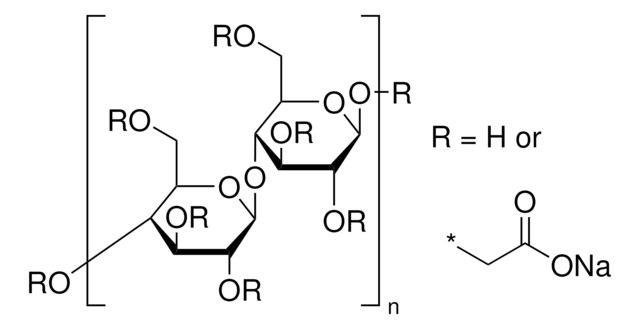C5678
Carboxymethylcellulose sodium salt
low viscosity
Sinónimos:
Sodium carboxymethylcellulose
About This Item
Productos recomendados
origen biológico
synthetic (organic)
Formulario
powder
color
light yellow
intervalo de pH útil
(20 °C, 10 g/L, 68 °F neutral)
viscosidad
50-200 cP, 4 % in H2O(25 °C)
mp
> 300.05 °C ((> 572.09 °F ))
solubilidad
water: soluble
trazas de catión
Na: 6.5-9.5%
temp. de almacenamiento
room temp
cadena SMILES
[Na].OC(C(O)C(O)C=O)C(O)CO.OC(=O)C
InChI
1S/C6H12O6.C2H4O2.Na/c7-1-3(9)5(11)6(12)4(10)2-8;1-2(3)4;/h1,3-6,8-12H,2H2;1H3,(H,3,4);
Clave InChI
DPXJVFZANSGRMM-UHFFFAOYSA-N
¿Está buscando productos similares? Visita Guía de comparación de productos
Descripción general
Aplicación
Nota de preparación
Under normal conditions, the effect of temperature on solutions of this product is reversible, so slight temperature variation has no permanent effect on viscosity. However, long periods of heating CMC solutions at high temperatures (autoclaving) will degrade the product and permanently reduce viscosity. CMC is therefore very difficult to sterilize. γ-Irradiation, like heating, will degrade CMC. High viscosity CMC is more adversely affected by autoclaving and irradiation than is low viscosity CMC. Filtering CMC solutions tends to leave a gel behind because the material is fibrous, so solutions cannot be sterile filtered.
Otras notas
Código de clase de almacenamiento
11 - Combustible Solids
Clase de riesgo para el agua (WGK)
WGK 1
Punto de inflamabilidad (°F)
Not applicable
Punto de inflamabilidad (°C)
Not applicable
Equipo de protección personal
Eyeshields, Gloves, type N95 (US)
Elija entre una de las versiones más recientes:
¿Ya tiene este producto?
Encuentre la documentación para los productos que ha comprado recientemente en la Biblioteca de documentos.
Los clientes también vieron
Nuestro equipo de científicos tiene experiencia en todas las áreas de investigación: Ciencias de la vida, Ciencia de los materiales, Síntesis química, Cromatografía, Analítica y muchas otras.
Póngase en contacto con el Servicio técnico

